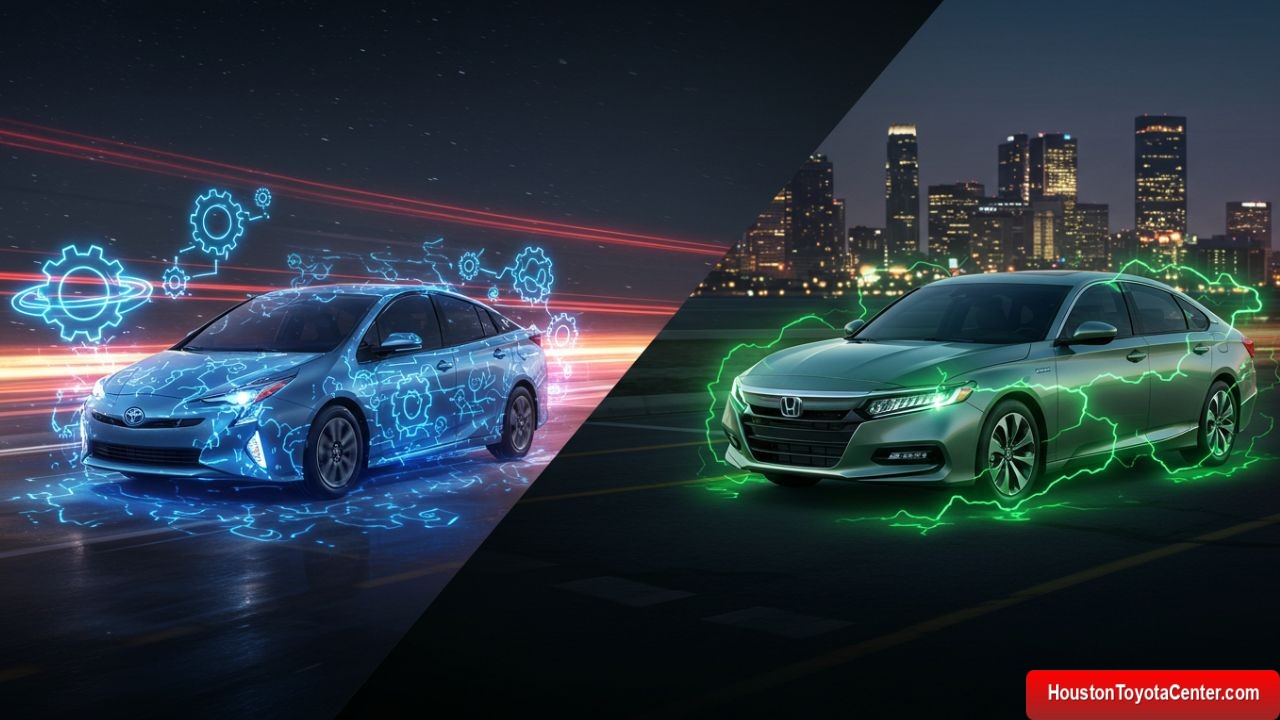In the ever-evolving automotive landscape, hybrid vehicles have established themselves as a critical bridge between traditional internal combustion engines and the all-electric future. Two major players dominate the hybrid market: Toyota, with its world-renowned Hybrid Synergy Drive (HSD) system, and Honda, with its innovative e:HEV and Integrated Motor Assist (IMA) systems.
While both automakers aim to improve fuel economy and reduce emissions, the methods they use to achieve this are significantly different. This article explores how Toyota’s Hybrid Synergy Drive stands apart from Honda’s hybrid technologies by analyzing architecture, performance, driving experience, battery integration, energy regeneration, and long-term reliability.
1. The Core Philosophy Behind Each System
Toyota Hybrid Synergy Drive (HSD)
Toyota’s approach is based on full hybrid architecture, meaning the car can operate on:
- Gasoline power only
- Electric power only
- A combination of both
The Hybrid Synergy Drive system is centered around seamless power delivery, prioritizing efficiency and smooth transitions between the gas engine and electric motor. It’s an advanced power-split hybrid, using a planetary gearset to distribute power.
FREE: Quickly identify and understand problems with your vehicle 🚘
CLICK HEREHonda’s Hybrid Approach
Honda has employed different systems over the years:
- Integrated Motor Assist (IMA) (older)
- e:HEV (i-MMD: Intelligent Multi-Mode Drive) (modern)
IMA was a mild hybrid, meaning the electric motor assisted the engine but couldn’t drive the car independently. In contrast, the e:HEV is a series-parallel hybrid, where the engine often acts as a generator, while the wheels are driven by electric motors most of the time.
Key distinction: Honda leans more toward electric motor-driven vehicles, whereas Toyota emphasizes power balancing and transition smoothness.
2. Powertrain Architecture Breakdown
| Feature | Toyota HSD | Honda e:HEV |
|---|---|---|
| Type | Full hybrid (power-split) | Series-parallel hybrid |
| Engine Usage | Works with or without engine | Engine primarily charges battery |
| Driving Modes | EV / Hybrid / Gas | Electric Drive / Engine Drive / Hybrid |
| Gearbox | Planetary gearset (eCVT) | Dual-motor with clutch |
| EV-Only Mode | Supported | Supported (briefly) |
| Battery Role | Supports EV mode and acceleration | Supports EV mode and energy regen |
| Motor Assist | Constantly working in harmony | Motor is the primary driver |
3. Driving Experience: What It Feels Like Behind the Wheel
Toyota HSD
Drivers often report:
- Whisper-quiet acceleration
- Smooth transitions between power sources
- Linear throttle response
- A more relaxed driving experience
- Predictable acceleration curves
The seamlessness is due to Toyota’s electronic continuously variable transmission (eCVT) that blends power effortlessly.
Honda Hybrid Systems
Drivers of modern Honda hybrids describe:
- A more responsive throttle, especially at low speeds
- A feel closer to an electric vehicle (EV)
- Noticeable engine startup noise when switching to engine drive
- Strong regenerative braking feel
In performance terms, Honda’s setup sometimes feels sportier, while Toyota’s feels more refined.
4. Energy Flow and Management
Toyota HSD Energy Flow
Toyota vehicles use a power-split device (a planetary gearset) to:
- Blend engine and electric motor power
- Seamlessly shift between modes
- Manage braking energy recovery
When braking or coasting, regenerative braking is applied to recharge the battery. This is managed through smart software that balances efficiency and power needs.
Honda e:HEV Energy Flow
In the e:HEV system:
- The engine usually powers a generator to produce electricity
- That electricity drives a traction motor
- At higher speeds, a clutch connects the engine directly to the wheels for better efficiency
Honda’s hybrid is more like an electric car with a gas-powered generator, at least most of the time.
5. Battery and Regeneration Strategies
| Attribute | Toyota HSD | Honda e:HEV |
|---|---|---|
| Battery Size | 1.3 kWh to 18.1 kWh (Prime models) | ~1.3 kWh |
| Chemistry | NiMH or Li-ion | Li-ion |
| Location | Under rear seats or trunk | Under rear seats |
| Regenerative Braking | Light to moderate | Strong and adjustable |
| EV Range | Up to 44 miles (in plug-in hybrids) | Limited (< 2 miles EV-only) |
6. Fuel Efficiency: Numbers That Matter
While both systems are designed to optimize MPG, their real-world fuel economy can differ.
Toyota Hybrids (2025 Models)
- Toyota Prius: Up to 57 MPG combined
- Toyota Corolla Hybrid: 50–52 MPG combined
- Toyota RAV4 Hybrid: ~40 MPG combined
- Toyota RAV4 Prime (PHEV): 94 MPGe
Honda Hybrids (2025 Models)
- Honda Accord Hybrid: 48–51 MPG combined
- Honda CR-V Hybrid: 40–43 MPG combined
- Honda Civic Hybrid (returning model): ~50 MPG (expected)
In general, Toyota’s PHEVs (Plug-in Hybrids) give it an edge in total fuel economy if you can plug in daily. Honda does not currently offer plug-in hybrids.
7. Long-Term Durability and Maintenance
Toyota’s Track Record
Toyota’s hybrid batteries are known for:
- Longevity (often exceeding 200,000 miles)
- Low failure rates
- Covered under 8-year/100,000-mile or 10-year/150,000-mile warranties (in CA)
Toyota has over 20+ years of hybrid experience, starting with the original Prius in 1997. Many early models are still on the road today.
Honda’s Reliability
Honda’s hybrids are also reliable, especially recent e:HEV systems. However:
- Older IMA systems didn’t age as well
- Honda hybrids are less common, so long-term data is limited
In terms of overall system maturity, Toyota still leads.
8. Real-World Use Cases: Who Should Choose What?
| Use Case | Toyota Hybrid Synergy Drive | Honda e:HEV Hybrid |
|---|---|---|
| Long-distance highway driving | Excellent | Very good |
| Urban stop-and-go traffic | Smooth and efficient | Quick and responsive |
| EV-like feel without plugging in | Moderate | Excellent |
| Need for plug-in capability | Available (Prius Prime, RAV4 Prime) | Not available |
| Preference for refinement | Toyota | |
| Sporty drive feel | Honda | |
| Proven track record | Toyota | Honda catching up |
9. Plug-in Hybrid Advantage: Toyota’s Secret Weapon
While both brands offer strong hybrid options, Toyota’s PHEV models like the Prius Prime and RAV4 Prime offer:
- Full EV mode for daily commutes
- Hybrid mode for long trips
- High MPGe ratings
- Tax incentives in many regions
Honda discontinued its Clarity Plug-in and has not yet announced a new PHEV.
10. Cost Comparison and Market Availability
| Model | Starting Price (USD) | Hybrid System | MPG / MPGe |
|---|---|---|---|
| Toyota Prius | ~$28,000 | HSD | 57 MPG |
| Toyota RAV4 Hybrid | ~$32,000 | HSD | 40 MPG |
| Toyota RAV4 Prime | ~$43,000 | HSD Plug-in | 94 MPGe / 44 EV mi |
| Honda Accord Hybrid | ~$33,000 | e:HEV | 48 MPG |
| Honda CR-V Hybrid | ~$34,000 | e:HEV | 40 MPG |
11. Software and Driving Modes
Toyota HSD
- Drive Modes: EV, Eco, Normal, Power
- Some models include EV hold and charge mode (Prime)
- Smart displays show energy flow and driving score
Honda e:HEV
- Drive Modes: ECON, Normal, Sport
- Driver can choose between engine and electric modes (indirectly)
- More hands-off system, reacts automatically
Toyota gives you more manual control, while Honda emphasizes automation.
12. Environmental Impact
Both systems drastically reduce carbon emissions compared to traditional cars. Toyota’s global fleet has:
- Reduced CO₂ emissions by millions of tons
- Sold over 20 million hybrids worldwide
Honda, with fewer hybrid models, is still catching up in scale but aims to electrify 100% of its lineup by 2040.
Conclusion: Which Hybrid System Is Better?
There’s no one-size-fits-all answer—but here’s how it breaks down:
Choose Toyota Hybrid Synergy Drive if you:
✅ Want a mature and proven system
✅ Need a plug-in hybrid option
✅ Prefer smooth, seamless power delivery
✅ Value long-term durability and resale
Choose Honda e:HEV if you:
✅ Prefer a more EV-like driving experience
✅ Like a sportier throttle response
✅ Trust Honda’s engineering innovation
✅ Don’t mind skipping plug-in options
In the end, both Toyota and Honda are pushing hybrid technology forward—but Toyota’s Hybrid Synergy Drive continues to set the benchmark for versatility, longevity, and balance.


Leave a Reply